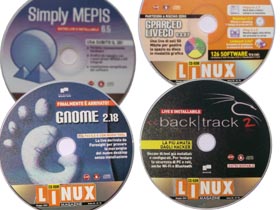Distro Review | Foresight 1.1 and SimplyMEMPIS 6.5
Other Linux Distributions:
One of the most challenging aspects of dealing with Linux is that there are hundreds of different Linux distributions whilst this is overwhelming to some, its confusing to others, especially for those trying to learn about Linux. Some years back it was normal to say, its easier to install and get started with Windows than a Linux Desktop. Nowadays that is no longer true. Declassifying on what Linux Desktop to use is neither a problem, most use the LiveCD and are hardware compatible. It is generally very easy to install Linux Desktops nowadays with the advent of the LiveCd. Most Linux Desktops are distributed as LiveCD. LiveCd permits you to try a distribution without having to install it. To make a LiveCD, its enough to download the ISO image and burn it to a disc. You can boot directly from the CD and try-out the system, above all, you can verify for yourself how compatible the distribution is with your hardware. You could try-out your Video, Audio and Network cards for example. If you’re satisfied then you can go ahead and install the distro as single or dual boot.
FORESIGHT LINUX 1.1
The Foresight Linux team took all by surprise and became the first to include the new Gnome 2.18 in its distribution. As a result all the most important software included as default in the Gnome Desktop have been updated: F-spot; personal photo management Beagle;search tool and Banshee; music player/manager.
Foresight adopts Epiphany as default browser, and includes Orca for those who sight problems.
Foresight uses the Anaconda installer that is well known to Linux users for it is the same installer used by Red Hat Linux and Fedora Core. This is a well tested installer that renders the installation very simple.
Conclusion: This distro is made to surprise you. Many things about Foresight are innovative.Its easy_to_use and very fast, plus a nice, clean default theme and artwork.
SIMPLYMEPIS 6.5
SimplyMEPIS is a Debian-based distribution that most Linux Desktop user would want to use. MEPIS. 6.5 started as a minor update to the Ubuntu pool compatible 6.0 release of SimplyMEPIS but the project quickly expanded to add the 7.1 X window manager, newer display and wireless drivers and even a Mac Intel support. I expected that SimplyMEPIS might look and feel a little more like Kubuntu now that it’s based in part on packages from Ubuntu, but it still has a unique flavor, and keeps its classentity.
SimplyMEPIS includes Gparted that provides the same functionality as a commercial disk partitioning program like Partition Magic. So you can also modify your NTFS partitions.The installation itself takes about 30 minutes and right after booting you’re ready to do almost every thing you need from a Desktop distribution. This is due to a good selection of packages.
SimplyMEPIS is KDE-based, but includes a lot of GTK+ applications in addition to KDE/Qt apps. For example, SimplyMEPIS ships with rather than for package management and updates. You also get OpenOffice.org, Firefox, Thunderbird, the GIMP, Amarok, and the usual cast of Linux applications. Since SimplyMEPIS is based on Ubuntu, many more are available from the SimplyMEPIS and Ubuntu repositories.
SimplyMEPIS also ships with a fair amount of non-free codecs and software enabled, so you’ll have support for MP3s, Flash, QuickTime movies, Java, and other goodies right out of the box.
It could also be fun trying out the Beryl 3D Desktop. With the SimplyMEPIS live CD, you can run desktop effects, via Beryl, before you commit to a hard drive install. Beryl worked well under my ATI graphics chips, but was rather unstable. But its good to know that Beryl is experimental. I’ve found the Ubuntu Feisty beta release with Compiz desktop effects far more stable than SimplyMEPIS and Beryl.
Conclusion: SimplyMEPIS has the right tools in the right places and makes no assumptions about the users’ knowledge of Linux. If you’re desktop distro shopping, I’d put SimplyMEPIS 6.5 in the list of distros to try. It’s a nice desktop and worth evaluating.
Also have a look at BackTrack 2.0. Its also known as the Hackers Distribution 🙂




